Backpack Counterpoint: Teton Sports Explorer 85L
Once again, I find myself with an unpopular opinion and feel the need to create a post explaining why everyone else is wrong 😁. This time it is regarding design trends in backpacking packs. It seems ultralighters are in control of the market and pack designers are catering to their wants and desires, or rather singular desire for extreme low weight and nothing else and ignoring the functionality rest of us would like in a pack. This all came to a head a few months ago when I decided I needed a larger pack for some of my trips after struggling to fit all the gear and food needed for a 3-day weekend trip with my family in my 65L Osprey Atmos AG. I struggled to find a new pack with the features I wanted. Almost all of the options out there are just big sausage tubes with no external pockets or organization. For example, this Hyperlite 85L pack weighs only 2.7lbs but has almost no functionality or convenience features:
Every major pack brand apparently aspires to this target and has moved away from multiple, usable, external pockets. I guess they do it in the name of weight savings, but most of the packs aren't even all that light. They are just stripped of features.
For example. My six-year-old 65L Osprey weighs about 4.5lbs according to the spec. It only marginally meets my needs. It has two external pockets, plus the brain pockets and a mesh stuff area. The biggest problem is the external pockets share space with the main internal chamber, so contents inside and content in the pockets fight for the same space. Not ideal.
At that point, Osprey was already halfway towards the evolving away from functionality trend. Now, 6 years later, they have just dropped the vestigial pockets completely. The Osprey Aether Plus 85 is their current 85 L pack and it cuts down the external pockets to just one on the back (and maybe a brain pocket, though you can't tell from the picture.)
This pack weighs 6lbs. Not exactly ultralight. Remember that weight for comparison later. How much weight is saved by ditching the external pockets? A few ounces? The convenience factor is greatly reduced, however.
Why Pockets?
I like external pockets to keep my gear organized and easily accessible. Having to shove everything into one big compartment is a pain if you need to get something while on the trail. For example, your water filter. Your fist aid kit. Your map. Your camera. Your lunch. Your chapstick. Your pocket knife. Your bathing suit. Your raincoat. Your toilet paper. Your hat. Your insect repellent. Your sunscreen. Your sunglasses. Your backup battery. These are all things that are great to have readily at hand in pockets. You can probably even have a friend grab them without having to take off your pack.
Back when I started backpacking, before internal frame packs were on the scene, a standard pack had one or two main compartments, a shelf or area for strapping a sleeping back, and 4 or more large external pockets for stashing the rest of your gear. They worked fine. I didn't even see the need to change to an internal frame pack for many years as my old external frame was still going strong. Eventually, that pack did wear out sometime around 2007. I had about a decade long break from backpacking at that point as kids arrived. I got the Atmos 65 AG around 2017 when the kids were old enough to start doing some light family backpacking trips. While that pack was comfortable and had some nice features, it often felt too small capacity-wise, and the lack of decent pockets always bothered me. Everyone raves about that pack and it gets great reviews. I figured I must be the problem and I would adapt to it. I never did.
I learned my lesson- I want a pack with more space and lots of external pockets. Problem: nobody makes a pack like that in 2023! WTF. Is everyone an ultralighter now? I don't like carrying extra weight with me, but I don't obsess over it. I want to be comfortable and prepared on my backpacking trips. I'm not through-hiking a long trail. I'm not going out to crush mileage. I don't need to do 15 mile days, and certainly not 20+. A 10 mile day (on New England trails with rocks, roots and steeps) with a 40lb pack is probably where my comfort threshold lies. I try to keep things under that. I want to have my comfy camp chair with me so I can sit by the lake for a few hours. I want my insulated mug to keep my coffee warm in the morning, as I sit by the lake again and soak in the beauty of my surroundings. I don't care about a few ounces. But apparently, I'm the only one who feels this way.
I hope that isn't the case. Maybe you are like me. Maybe we are the silent majority. Well, silent no longer! I'm going to say it: The emperor has no clothes on! Or I guess, in this case, the ultralighter has no clothes on. Because they didn't have room for spares in their pack. There is a new hope, my friends. I found a pack that I have now taken on a couple of trips and am pretty happy with. As an added bonus, it is incredibly affordable. It is the Teton Sports Explorer 85L (I get no promotional consideration from Amazon, so go buy it wherever you can get the best deal).
Many people will tell you to stay away from cheap no-name packs. Often with good reason. You don't want something that is going to fail or fall apart on you when you are miles out in the backcountry. In this case, I literally had no other choice. The name brands aren't making what I want. So I took a chance on it. Why I bought it: 1. It is 85L, twenty more than my old Atmos and hopefully enough for at least a 3 or 4 day trip. 2. Look at the beautiful, beautiful pockets 😍 Three good sized pockets on the side, a large pocket on the back. A big pocket in the lid. Two lower mesh pockets for holding my Nalgene bottles. The only thing missing from it is a detachable daypack. Oh well. It is large enough that I can throw a daypack in the main compartment.
I should also clarify that I am lumping Teton Sports in with no-name manufacturers because I don't typically see their gear reviewed in Backpacker or prominent online gear portals like you see with Osprey, The North Face, Kelty, etc. They could be an up-and-comer, or maybe they just don't send freebies out for review. Based on my experience with them so far, I see no reason why they shouldn't be considered a legit brand other than their prices are too low.
My Teton Sports Explorer 85L Review
As mentioned above, I've had this pack for a couple months and taken two trips with it so far. And let me say at the outset, it has exceeded my expectations.The good:
- The 85L size is fantastic. I finally feel like the pack has the same hauling capacity that I used to get from my old external frame packs. I didn't even fill it on either of my trips and had room to haul more stuff- great if I need more food for a longer trip.
- Weight: 5.8lbs, including built-in rain cover. Remember above- this is less than the nearly pocketless turd-shaped Osprey Aether 85L which weighed 6lbs. Apparently no-name Teton Sports can out-engineer Osprey and fit pockets on their packs and also come in at a lower weight. You can have your cake and eat it too!
- Comfort. My first trip was a weekend trip hauling a 36lb load over the top of Stratton Mountain in Vermont. Comfort was acceptable. My old Atmos probably has the edge in comfort due to the mesh backing that reduces sweat buildup on your back, but this pack did alright. At first the Teton Explorer felt off-balance like it was trying to pull me backwards somewhat, but I solved that by putting my heavy bear canister (filled with food and stuff) in the lower sleeping bag compartment and putting my lighter sleeping bag higher up in the pack. After that, it was good and didn't cause me any discomfort for the rest of the trip.
- The external pockets have a place for everything. All of the items mentioned above in my rant, plus more fit in those pockets. 💖💝💟
- Quality. Everything seems to be of high quality. The stitching all seemed good. The buckles don't feel like they are going to break easily. How it holds up over time will be the real test here.
- Price: $89 on sale. I love a bargain. When I have specific needs, I am usually willing to pay for them. I thought the Osprey Atmos 65AG was going to meet those needs, which is why I spent a good deal of money for that pack in the first place. I came away underwhelmed. This pack, on the other hand, best meets my needs and is extremely inexpensive for a pack in this category. Again, having my cake and eating it too!
- The hip belt pockets have a Velcro latch that lets them pivot up so you can put the tails of the hip belt tightening straps under them to keep them neatly out of the way. Awesome touch! On the Atmos, you have to push the straps behind the pockets. You can't push a string. Or straps.
- Another positive is the help belt can cinch tight enough to fit my waist and still has some room for me to lose a few pounds. The Atmos hip belt also just barely fits me at its tightest. I'm not exactly small-waisted, so I'm surprised there isn't more adjustment to the small side in the Atmos.
- Teton Sports says they have a lifetime warranty. I don't know if it is as renowned as Osprey's famous no-questions-asked lifetime warranty. Probably not. But I guess it is better than nothing.
- The water bottle pockets aren't as accessible as they are on the Atmos 65 AG. The Atmos has nicely forward tilted mesh slots that you can easily slide your bottles in and out of while on the trail without having to take the pack off. With the Explorer, I was still able to do so with the left one, though it wasn't as easy. The right one was tougher as the bottle couldn't clear the pocket easily when it was stuffed full making it hard to get back in. I could use a water bladder instead, but those are kind of a pain to use and you risk getting leakage or condensation inside your pack with them, so I prefer external bottles.
- When the pack isn't very full, the lid tends to slide off the back leaving part of the top exposed and potentially could let rain or debris in. I wish you could tighten down the part of the lid closest to your neck more. On the other hand, I didn't have problems with the lid being a little loose, and if it rains hard enough, you can put on the built-in rain cover.
- The pads at your back create sweat points. As mentioned above, the Atmos has better ventilation. The full mesh backing on it does a good job at letting sweat out and keeping you cool. The Explorer has a couple of soft pads that rest on your back. These points accumulate sweat. I found that at pack-off rest points, my shirt was soaked at those spots and quickly cooled down and actually got chilly from the evaporation. To be fair, many packs have this problem, the Atmos AG happens to be one of the few that have figured out how to minimize it. I didn't really appreciate how well it was working until I went on a trip with another pack. Kudos to Osprey engineers on that one. You can see the difference in the side-by-side photo below.
- Color choice is extremely limited on this pack. There is black or black and tan. The black one was the only one on sale when I got it, so at least I didn't have to wrestle with a color decision.
- Despite the side pockets, the pack has pass-through slots between the main body and the side pockets that let you put long items, like tent poles, in there. The only downside is the bottom is the same pocket as the water bottles use, so you may have to choose which function you want. Here are some trekking poles slid behind the pockets illustrating the function.
- The sleeping bag compartment is roomy. My Backpacker's Cache bear canister fits in there with room to spare. Or I can fit my 0 degree Enlightened Equipment quilt, Thermarest NeoAir X-lite insulated pad and Trekology inflatable pillow all in there at the same time. Here's the bear canister easily fitting in the compartment with room to spare.
- The sizing scale on the back for shoulder strap adjustment seems off to me. I'm not quite 5'10" and found I had to put the straps above the XL positioning to get the right fit so the straps weren't pulling down on my shoulders. It's not a problem, just odd.



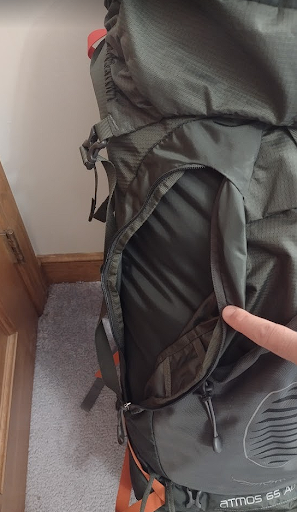

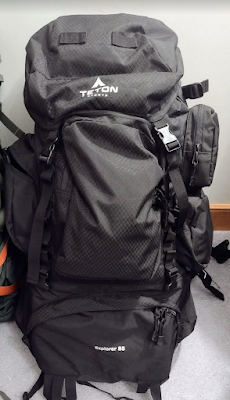
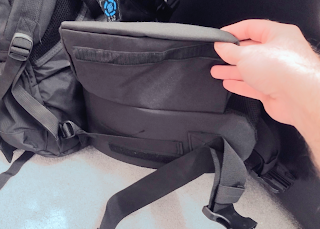
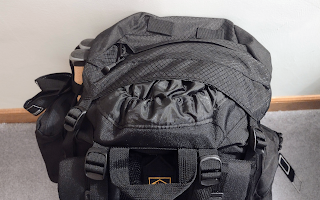

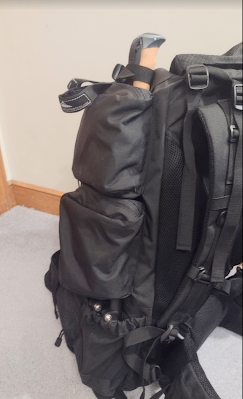

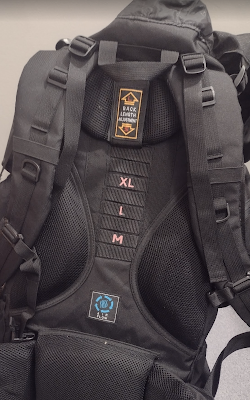



Comments
Post a Comment